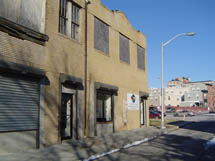 |
|
|
Politics
Main Page |
|
Shelter Space Continues Falling, as Baltimore's Homeless Population Stays Steady
Capital News Service Friday, Oct. 12, 2007 ANNAPOLIS - Baltimore's homeless population continues to hover around 3,000 people, while the number of emergency and short-term shelter beds in the city has fallen to 2,260 in the last count. The steady decline in shelter space continued this month, with the Oct. 1 closing of the city's 73-bed YWCA shelter. "Prior to this current situation, there's always been an inadequate supply of beds," said Stephanie Archer-Smith, deputy director of St. Vincent de Paul of Baltimore. "People are turned away from shelters on a regular basis." But advocates say that while the shelter shortage is a problem, the long-term solution is not more shelter beds, but more funding in affordable housing. "It's a combination of low incomes, rising rent and utility costs, and no way to close the gap between the two, so people are struggling," said Greg Shupe, director of the Office of Transitional Services, which is charged with combating hunger and homelessness in the state. At least 3,000 people were living on Baltimore's streets, according to a one-day census of the city's homeless population in January. That number has been unchanged since the census began in 2005. One-quarter of them have been homeless for at least three years, a proportion that has increased. Meanwhile, the number of emergency and transitional shelter beds in Baltimore has dropped from 2,439 in 2004 to 2,260 in 2006, according to annual reports from Shupe's office. "The provider networks are stretched quite thin," said Adam Schneider, community relations associate for Health Care for the Homeless in Baltimore. Emergency shelters provide beds on a night-to-night basis. Transitional shelters provide them to the same person for up to a few months at a time. Both are the final safety net against spending the night on the streets for individuals and families who have lost traditional housing. Shupe said year-to-year fluctuations in the number of beds in Baltimore could be the result of the voluntary reporting from shelters that his agency relies on. But "it gives a sense of how much unmet demand there is," he said. Advocates say the demand for homeless services remains strong because of underfunded public housing, rising housing prices and other economic pressures that are affecting many parts of the country, not just Baltimore. More than 29,000 households are on the city's waiting list for public housing and rental assistance programs, according to an annual plan the city submitted to the U.S. Department of Housing and Urban Development in May. That report also said the Housing Authority of Baltimore City lost more than $22 million in federal funding in 2006 and 2007 and was forced to cut 292 staff positions. "It's no surprise that when we stopped investing in affordable housing, there are fewer people who can find affordable housing," Schneider said. In the meantime, he said, "inadequate shelter services are becoming increasingly inadequate." The Baltimore YWCA closed Oct. 1 because of a lack of funding from public and private sources. City officials are trying to replace most of those lost beds at an East Baltimore shelter run by the Collington Square Nonprofit Corp., said Diane Glauber, the president of Baltimore Homeless Services, a city agency. "We should have by the end of the year 64" new beds to replace the lost ones, Glauber said. A second shelter closed earlier in the year because of fire code violations. Even with replacements, the city will suffer a net loss of 40 beds, Glauber said. To ease some of the pressure on shelters with winter coming on, the city is working to find a location for its seasonal Code Blue shelter. Open on freezing nights from November to March, the shelter is expected to add 300 beds to city capacity. "It's our number one priority and we're devoting all our resources to it," Glauber said. Copyright © 2007 University of Maryland Philip Merrill College of Journalism Banner graphic by Hortense Barber and Diego Mantilla. Banner photos of homeless person's cart and homeless man sitting are courtesy of Greg Sileo.
|

